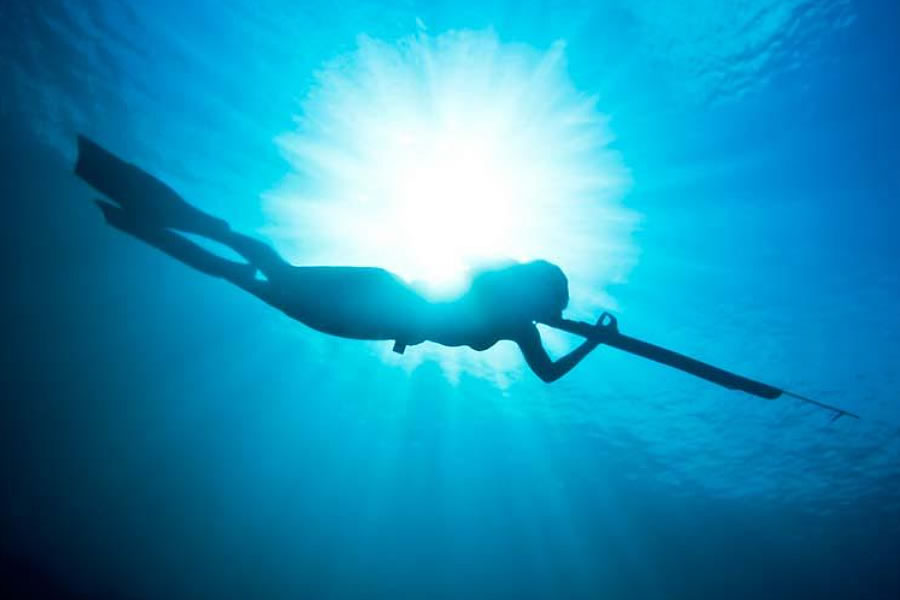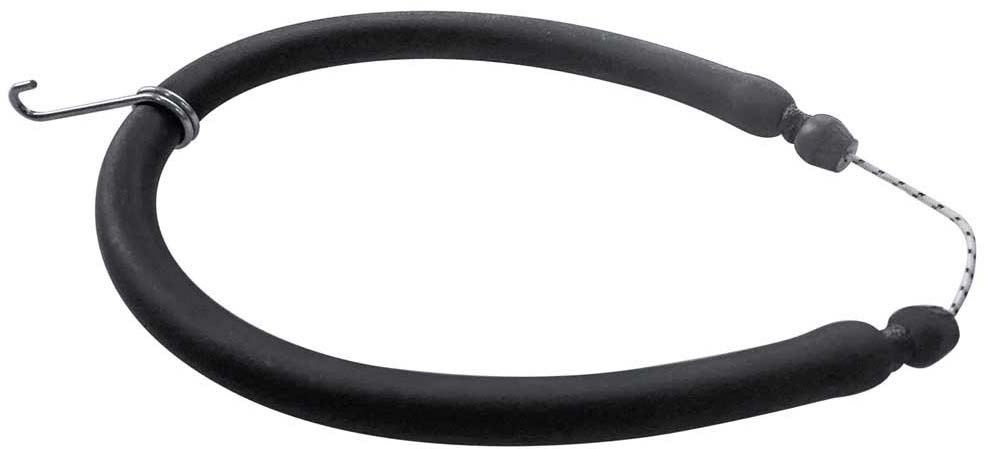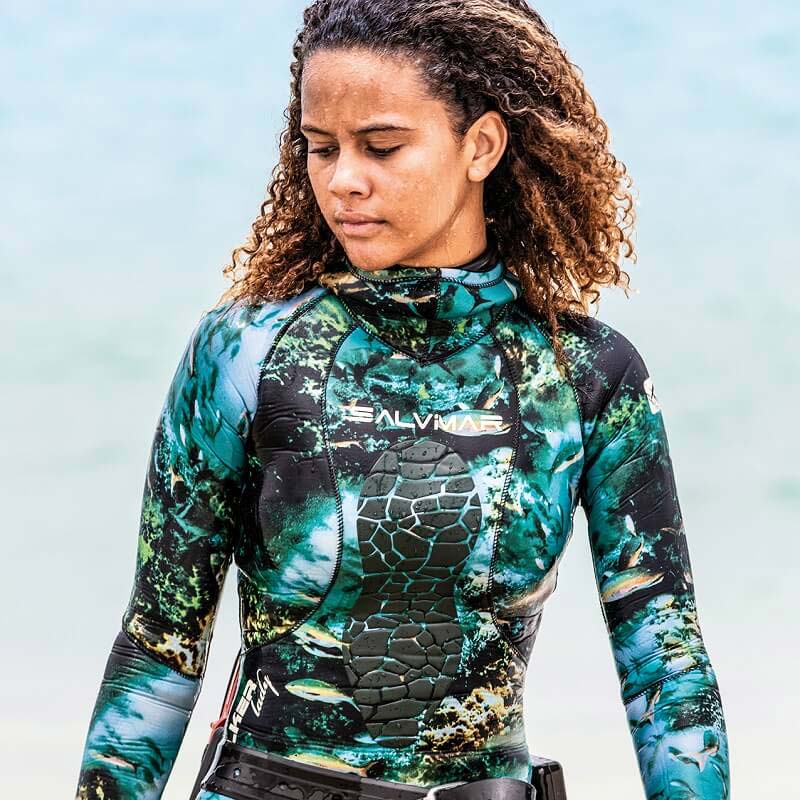🇬🇧 Spearfishing: become a women huntress and catch your food sustainably

Discover the beautiful, peaceful sport of spearfishing, how to start out and which equipment to choose for women.
Humans have been hunting and harvesting their own food for 2 million years – but nowadays most of us prefer to grab something convenient, packaged and processed from the supermarket shelves. This has led to thriving, environmentally-harmful industrial meat and fishing industries that are killing off our planet, and damaging our bodies. Spearfishing is a natural, beautiful and peaceful alternative that ensures your food is ethically harvested from a sustainable source.
Many women progress to spearfishing from freediving which in my experience, they are very good at. Perhaps it is because they generally tend to use their lower-body strength more than men – consequently they kick less to cover the same distance which uses less air and allows them to dive for longer. Or perhaps it is that women are thought to be better at interpreting visual information: an absolute must when under the water. Another thought is that more women practice yoga than men, which is a perfect complement to both freediving and spearfishing. Both sports offer total immersion in nature with the same oneness and presence; with yoga providing benefits that will boost your diving skills such as focusing the mind to lower your heart rate, leading to longer and more comfortable bottoms times.
For women starting out in spearfishing, it’s important to get the right equipment and this means appreciating from the start that men and women are physiologically different. I really cannot emphasise enough how important it is to talk to real spearfisher men and women when choosing your kit because we are not ‘one-size-fits-all’. Choose equipment that works well for women and you will not only have a safe and enjoyable experience, but you’ll also be a more effective hunter. I’ll cover some of the main considerations for women’s kit below.
Speargun
Your choice of gun depends on a couple of things. First, what kind of spearfishing do you intend to do? Will you dive off a boat, or hunt from the shoreline? Are you hunting down bigger prey in very deep waters? Naturally if you’re targeting very big fish, you’ll need more power – but loading a more powerful gun is not easy. Some of us don’t have enough strength and you don’t want to burn yourself out loading your gun and leave yourself no energy for the diving. For this reason women tend to get on better with guns that have more forgiving bands. You can apply this to all gun setups – and while a single 14 band gun maybe okay for you for hunting small fish on reefs, you can easily double or triple up for longer range hunting or targeting bigger species. For larger blue water guns, I’ve seen people using 5 x 14mm bands very effectively.
Another option, say for blue water hunting: you might try a load assist. It’s a round piece of rubber that you wear over your arm and it makes a huge difference. It helps on two fronts: it allows you to easily reach the band for the initial pull stroke of the loading process getting it to a loading tab mid way up the shaft. From there you can reposition the speargun into a comfier spot where you have more power to finish off the loading cycle. Secondly, you may well find this technique makes loading 16mm bands easy enough to leave the 14mms at home. It’s a little more faff but bluewater guns are anyway.

Above – a load assist by Salvimar
Wetsuit
If you’re coming to the sport from another type of water sport you may be tempted to use your current wetsuit and that’s fine to get you started but there are some significant differences to be aware of that will affect your diving experience.
Most water sport wetsuits are designed to be used on top of the water, not below it. This means they will compress wafer thin when bottom side and offer you next to no protection from the cold.
Wetsuits are all a compromise of compression resistance, comfort / stretch and durability. As most water sport suits don’t need to compression resistance, they will have extra points in the comfort / stretchy section.
While neoprene has come a long way in recent years, they will never be ‘as’ comfy as say, a surf suit, but they will keep you warm when you’re 20m below the surface.
Spearfishing wetsuits are normally 2-piece: a jacket and pair of pants. The pants are either high waist, or come with shoulder straps know as farmer johns.
If you speak with any wetsuit manufacturer, they will happily describe the complications of trying to find the perfect cut to fit all women – basically it’s impossible. Hips, bums and chest all fluctuate wildly between women, making the perfect suit selection a real headache. The best thing you can do is to speak with a shop that stocks a wide range of suits. Every brand’s wetsuits are tailored to a different cut – no 2 wetsuits are the same and this is the same for both men’s and women’s suits. Speaking to someone with experience with many different brands will massively improve your chances of getting that perfectly snug suit.
The snugger fitting the wetsuit, the warmer you will be. It’s those pockets of water that appear in poor fitting suits that make you cold, so the aim is to eliminate them from appearing by having a suit that hugs your body from ankle to neck.

Above: Salvimar Sea Walker wetsuit for women
Most women spearas prefer the high waist trousers too, as the long johns don’t fit well over our chests. With these type of trousers it’s easier for us to go to the toilet as well, as we don’t have to remove the jacket. I have Salvimar’s Sea Walker wetsuit which is 5.5mm and for me it’s perfect for diving the UK, all but the 3 months of winter where I opt for a thicker 7mm jacket/5.5mm pant combination.
However, this might not work for everyone: everyone is different and feels the cold in their own personal way. Although women typically have a higher percentage of body fat than men, it’s my experience that they don’t always notice this higher degree of insulation against cold water and we tend feel the cold a bit quicker! If you’re prone to getting cold quickly, a 7mm top with 5mm bottoms could be the way to go all year round. If this extra bit of thickness keeps you happier for longer then you’ll be a better diver for it. Remember that with this combination, you get 12mm around most of your core.
It might be tempting to go thicker, but unless you’re diving in really cold waters, I wouldn’t recommend it as there is an annoying trade off! Wetsuits are made of neoprene and this is a very buoyant material. A thicker suit means you’ll need more weight on your belt to find your negatively buoyant sweet spot. This can make the walk to your dive spot, and movement in general, a real pain – and generally more exhausting.
Remember though, wetsuit thickness is mostly down to the water temperature you are hunting in, the depths you normally dive, the usual weather conditions and how long you like to spend in the water. Beyond that, you can fine tune it to your specific needs. Your local dive shop will be able to help you with all of this.
The ultimate way to get a suit that fits to perfection is to go custom and have one tailor made specifically for you and your measurements. Polosub do a fantastic range of custom wetsuits that are surprisingly affordable.
There is a fantastic guide to spearfishing wetsuits on this site, with a lot more helpful information (scroll down underneath the products).
Gloves and socks
For the UK I tend to use 2-3mm gloves for most of the year for temperatures around 12-14 degrees. When it drops below that, I’ll switch out for 5mms. Where I dive in the UK winter tends to touch 9 degrees at its worse.
You would think that you would lose a lot of dexterity with such thick gloves but surprising this isn’t the case. Sure, it makes a few finer tasks a little more tricky but generally I don’t notice the difference.
Always make sure these are in good condition before you dive, not just to protect from the cold but also to avoid cuts from rocks and fish spikes.
With socks I just use 5mm all year round. They are extra warm and cushiony so as long as I don’t overheat, why not!
Also, don’t underestimate the difference that having warm hands and feet can make to your dive experience. When they are cold and stinging, it makes your whole body feel freezing even when you’re actually okay – it’s a real psychological win to get those extremities warm.
One thing to bear in mind when buying gloves and socks is that they you will burn through them as the season progresses, so don’t feel you have to spend heaps of money here, as you’ll be replacing them before you know it.
Fins
Again, if you’ve come to spearfishing from another sport, you might already have scuba fins, but please don’t use them. They are far too rigid as they are designed for a different purpose and (from past experience) they genuinely can cause horrific cramp and ankle pain.
Aside from choosing a fin specifically designed for spearfishing, you also need to look at the rigidity. Women typically have a smaller skeletal size and bone mass than men even with a comparable body size, together with less muscle mass so we’re usually lighter – and can therefore get away with a softer blade. By contrast, a firmer blade on a light person can really put strain on the ankles, cause cramp and wearing the legs out too much, so it’s important you get it right.
The type of spearfishing you’re doing is relevant here too – if you’re diving deep, you may edge towards a slightly firmer fin – by contrast, if you’re shore diving and doing most of your distance on top of the water, you can edge towards a softer blade.
My favourite fins are by DiveR and they are made from a composite material called Carbon Innegra which combines the stiffness and strength of carbon fibre with all the benefits of Innegra fibres: impact resistance, lightness, durability and more. They’re on the pricey side for sure, but they are really forgiving which means my legs and ankles hold out for longer.
Weights
Correct weighting is a very specific setup to you, your body type and where and how you are diving. Here you are best assisted by an expert in person.
However I would add that spreading your weight between a belt and also a harness will really help to take that pressure off your lower back, spreading it around and make your diving a bit more comfortable. A vest also helps you perform a smoother duck dive which in turn, will help you preserve your energy.
Other items
Aside from the above kit, the items you choose will be the same as for men. You’ll need a mask, snorkel, float, stringer and knife as a minimum. The float warns other water users such as people in boats that there’s a diver beneath the water so that they can avoid you, so it’s an essential piece of kit.
Getting into spearfishing
Once you’ve organised your kit, you might be wondering what to do next. The best way to start out is to get involved with a local club – there are plenty along the south coast of the UK. You’ll also find a very helpful community on @ukspearfishingbuddies on Facebook with spearos and a growing number of spearas. You’ll receive a warm welcome and usually plenty of offers to buddy-up. This is very important point – you should always dive with at least one other person so that you can look out for each other. Early on, it helps to pair with someone experienced as there are so many little tricks and safety points that you simply wouldn’t even consider, until you’re out in the water. You could also spend a couple of days on a spearfishing course to help you learn the basics and build your confidence.
Author: Jen Wiss-Carline
Email: jenniferlwiss@gmail.com
Last Updated on April 6, 2021

